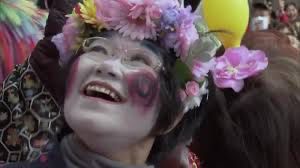
Laughter holds a unique place in Japanese culture, and it even finds echoes in Shinto rituals and customs, where joy and positive energy are highly valued. Shinto, Japan's indigenous belief system, emphasizes the importance of harmony with nature, the presence of kami (spirits), and purity of the mind and body. In Shinto, laughter is considered a powerful expression of joy that can cleanse the spirit and help connect with the kami.
1. The "Laughing Ritual" (Warai Matsuri)
One of the most well-known examples of laughter being central to Shinto customs is the Warai Matsuri (笑い祭り), or Laughing Festival, held annually in Wakayama Prefecture. This festival dates back over 1,200 years and is rooted in the belief that laughter pleases the kami and invites their blessings. Legend has it that the local deity, Niutsuhime no Mikoto, went missing, and villagers began to laugh to draw her back from hiding. The loud, joyous laughter eventually succeeded in summoning the kami, and since then, the festival has been celebrated to ensure prosperity and good fortune. During the event, participants and priests engage in bouts of collective laughter, offering laughter as a form of prayer to bring good fortune to the community.
2. Laughter in Celebratory Shinto Rituals
Laughter is also seen during other festivals and rites, where joy and playfulness are infused into ceremonies. For example, during the Setsubun festival (celebrating the start of spring), people throw beans while laughing or shouting to chase away evil spirits and invite luck. Laughter in this context is believed to drive away negative energies and help protect homes and families.
3. Laughter as an Expression of Purity
In Shinto, laughter is seen as a purifying act, similar to the way water or salt is used in purification rituals. Laughter is believed to cleanse negative emotions and impurities from the soul. By laughing, people can release stress, sorrow, and impurity, thus restoring a state of musubi (harmony and connection with nature and the kami).
4. Laughter as an Act of Joy and Gratitude
Shinto rituals emphasize gratitude to the kami for life's blessings, and laughter is one way of expressing this joy and appreciation. During festivals (matsuri), laughter is encouraged as part of the celebratory atmosphere, reflecting the happiness and gratitude of the community.
5. Kami of Laughter
Shinto mythology includes references to gods associated with laughter and joy. One famous story is about Uzume, the goddess of dawn, who used laughter to coax the sun goddess, Amaterasu, out of hiding. In this myth, the world was cast into darkness when Amaterasu retreated to a cave. Uzume performed a comical dance and laughed so loudly that it drew the curiosity of Amaterasu, who peeked out from the cave, bringing light back to the world. This myth highlights the divine power of laughter to uplift spirits and restore balance.
In conclusion, laughter plays a significant role in Shinto rituals and customs, symbolizing joy, purification, and connection with the spiritual world. Whether through festivals like the Warai Matsuri or the expression of gratitude during ceremonies, laughter is seen as a way to honor the kami and maintain harmony with the natural and spiritual world.


